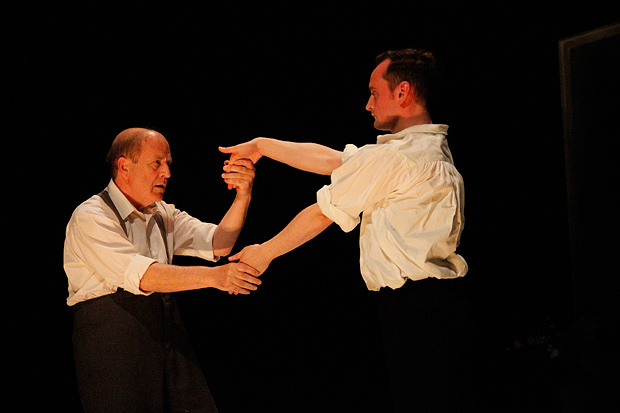@ Brunton Theatre, Musselburgh, on Sat 7 May 2016 (and touring)
Stage depictions of mental health problems are rarely populist viewing, and Kally Lloyd-Jones‘ two-hander about the schizophrenic Russian ballet wunderkind is even less so, rooting itself in the specific, with little heed of the universal. On a fairly sparse, dressing-room style set that hints at its era, an old Nijinsky outpours his introspections, while his younger self connects with the world through the dances that made him famous. And it is Nijinsky under the microscope, not fame, nor mental health. Sixty years dead, a century since his career high, he retains this cachet.
Last Jump has the hallmarks of a labour of love – it’s clear the writer cares about Nijinsky’s mental state and its relation to his genius, it’s less clear why we should, if we don’t already. There’s little signposting, few factual snippets onto which to grasp (not aided on this particular evening by an audience member at the back of the hall shouting, “We can’t hear you!” for the first few scenes – “old” Nijinsky, James Bryce, might be understated of manner and gentle of tone, but he is audible).
Instead, the play relies on impressionistic snapshots from periods of Nijinsky’s life to give a sense of the man. There’s an uncomfortably matter-of-fact reflection upon teenage masturbation – pent-up energy he eventually channelled into his work. There’s a segment from Petrushka, the significance of which is hard to fathom without prior knowledge of his work. It’s only during a strait-jacket scene, powerfully danced by “young” Nijinsky, Darren Brownlie, to the Rite of Spring, that movement, music and meaning gel into a fully satisfying whole.
Elsewhere, the piece, based on chunks of his diary, tends to aphorisms, as some diarists are wont to do. They plague a potentially revelatory conversational scene between young and old Vaslav, where clarity has been sacrificed for profundity. Some insights shine through – his quest for beauty, his pondering whether sanity is merely not feeling quite so much (Nijinsky is John Stuart Mill’s unhappy philosopher not his happy pig). And some are brought beautifully back into the closing scene. Nijinksy’s description of jumping stays in the mind, and is employed judiciously at key junctures.
Despite reservations about its method, Nijinsky’s Last Jump makes its point well enough. A schizophrenic in those days, subjected to “throw-the-kitchen-sink-at-it” treatments like insulin-induced comas, was a finished man, a human experiment, regardless of the skills they possessed. Lloyd-Jones, in her programme notes, muses that maybe Nijinsky could have kept working if understanding of mental illness had been different in 1919. The horrendous treatments may have gone, but even 100 years on, that seems doubtful.


Comments